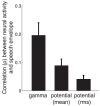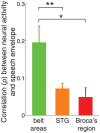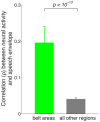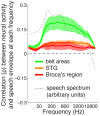The tracking of speech envelope in the human cortex
- PMID: 23408924
- PMCID: PMC3542338
- DOI: 10.1371/journal.pone.0053398
The tracking of speech envelope in the human cortex
Abstract
Humans are highly adept at processing speech. Recently, it has been shown that slow temporal information in speech (i.e., the envelope of speech) is critical for speech comprehension. Furthermore, it has been found that evoked electric potentials in human cortex are correlated with the speech envelope. However, it has been unclear whether this essential linguistic feature is encoded differentially in specific regions, or whether it is represented throughout the auditory system. To answer this question, we recorded neural data with high temporal resolution directly from the cortex while human subjects listened to a spoken story. We found that the gamma activity in human auditory cortex robustly tracks the speech envelope. The effect is so marked that it is observed during a single presentation of the spoken story to each subject. The effect is stronger in regions situated relatively early in the auditory pathway (belt areas) compared to other regions involved in speech processing, including the superior temporal gyrus (STG) and the posterior inferior frontal gyrus (Broca's region). To further distinguish whether speech envelope is encoded in the auditory system as a phonological (speech-related), or instead as a more general acoustic feature, we also probed the auditory system with a melodic stimulus. We found that belt areas track melody envelope weakly, and as the only region considered. Together, our data provide the first direct electrophysiological evidence that the envelope of speech is robustly tracked in non-primary auditory cortex (belt areas in particular), and suggest that the considered higher-order regions (STG and Broca's region) partake in a more abstract linguistic analysis.
Conflict of interest statement
Figures

 .
.
 ) between the speech envelope and gamma activity for each channel in belt areas surrounding the auditory core. Filled bars denote the cases of significant correlation (
) between the speech envelope and gamma activity for each channel in belt areas surrounding the auditory core. Filled bars denote the cases of significant correlation ( ). The star refers to the example channel shown in Figure 1 and Figure 5.
). The star refers to the example channel shown in Figure 1 and Figure 5.
 SEM Spearman correlation coefficient (
SEM Spearman correlation coefficient ( ) between each neural signal and speech envelope. The mean is computed across all channels in the belt areas (
) between each neural signal and speech envelope. The mean is computed across all channels in the belt areas ( ).
).
 SEM Spearman correlation coefficient (
SEM Spearman correlation coefficient ( ) between neural activity and speech envelope in each region of interest. The mean is computed over all channels in each area (
) between neural activity and speech envelope in each region of interest. The mean is computed over all channels in each area ( ,
,  ,
,  ). Stars denote the significance of the difference in means (two-tailed t-test), *
). Stars denote the significance of the difference in means (two-tailed t-test), * , **
, ** .
.
 at each channel for the individual subjects (A–E), and for the subject average (AVG). Individual channels implanted in each subject are shown in green (belt areas), orange (STG), red (Broca's region), or black (other regions). The location of each channel was determined using the Talairach Atlas daemon (see Methods). In subject C, the arrow points to the channel for which we illustrated the tracking effect (Figure 1). STS: superior temporal sulcus; SF: Sylvian fissure; TTS: transverse temporal sulcus (perpendicular to the view plane).
at each channel for the individual subjects (A–E), and for the subject average (AVG). Individual channels implanted in each subject are shown in green (belt areas), orange (STG), red (Broca's region), or black (other regions). The location of each channel was determined using the Talairach Atlas daemon (see Methods). In subject C, the arrow points to the channel for which we illustrated the tracking effect (Figure 1). STS: superior temporal sulcus; SF: Sylvian fissure; TTS: transverse temporal sulcus (perpendicular to the view plane).
 SEM Spearman correlation coefficient (
SEM Spearman correlation coefficient ( ) between neural activity and speech envelope in belt areas (green) and all other regions (gray). The mean is computed over all channels in each case (
) between neural activity and speech envelope in belt areas (green) and all other regions (gray). The mean is computed over all channels in each case ( ,
,  ).
).
 SEM Spearman correlation coefficient (
SEM Spearman correlation coefficient ( ) between neural activity and speech envelope for each frequency, for each region of interest. The dashed line gives the average spectrum of the speech in logarithmic units.
) between neural activity and speech envelope for each frequency, for each region of interest. The dashed line gives the average spectrum of the speech in logarithmic units.
 SEM Spearman correlation coefficient (
SEM Spearman correlation coefficient ( ) between neural activity and the speech envelope, for each region of interest. Left: stimulus containing lyrics. Right: melody. The mean is computed across all channels in each area. Stars denote the significance of the difference in means (t-test), *
) between neural activity and the speech envelope, for each region of interest. Left: stimulus containing lyrics. Right: melody. The mean is computed across all channels in each area. Stars denote the significance of the difference in means (t-test), * , **
, ** .
.Similar articles
-
Stimulus-dependent activations and attention-related modulations in the auditory cortex: a meta-analysis of fMRI studies.Hear Res. 2014 Jan;307:29-41. doi: 10.1016/j.heares.2013.08.001. Epub 2013 Aug 11. Hear Res. 2014. PMID: 23938208 Review.
-
Linear phase property of speech envelope tracking response in Heschl's gyrus and superior temporal gyrus.Cortex. 2025 May;186:1-10. doi: 10.1016/j.cortex.2025.02.015. Epub 2025 Mar 15. Cortex. 2025. PMID: 40138746
-
Neural Tuning to Low-Level Features of Speech throughout the Perisylvian Cortex.J Neurosci. 2017 Aug 16;37(33):7906-7920. doi: 10.1523/JNEUROSCI.0238-17.2017. Epub 2017 Jul 17. J Neurosci. 2017. PMID: 28716965 Free PMC article.
-
Mapping phonemic processing zones along human perisylvian cortex: an electro-corticographic investigation.Brain Struct Funct. 2014 Jul;219(4):1369-83. doi: 10.1007/s00429-013-0574-y. Epub 2013 May 26. Brain Struct Funct. 2014. PMID: 23708059 Free PMC article.
-
Segmental processing in the human auditory dorsal stream.Brain Res. 2008 Jul 18;1220:179-90. doi: 10.1016/j.brainres.2007.11.013. Epub 2007 Nov 17. Brain Res. 2008. PMID: 18096139 Review.
Cited by
-
Electrocorticographic mapping of expressive language function without requiring the patient to speak: A report of three cases.Epilepsy Behav Case Rep. 2016 Mar 9;6:13-8. doi: 10.1016/j.ebcr.2016.02.002. eCollection 2016. Epilepsy Behav Case Rep. 2016. PMID: 27408803 Free PMC article.
-
High-frequency neural activity predicts word parsing in ambiguous speech streams.J Neurophysiol. 2016 Dec 1;116(6):2497-2512. doi: 10.1152/jn.00074.2016. Epub 2016 Sep 7. J Neurophysiol. 2016. PMID: 27605528 Free PMC article.
-
The Lateralization of Speech-Brain Coupling Is Differentially Modulated by Intrinsic Auditory and Top-Down Mechanisms.Front Integr Neurosci. 2019 Jul 17;13:28. doi: 10.3389/fnint.2019.00028. eCollection 2019. Front Integr Neurosci. 2019. PMID: 31379527 Free PMC article.
-
Hearing Impaired Participants Improve More Under Envelope-Transcranial Alternating Current Stimulation When Signal to Noise Ratio Is High.Neurosci Insights. 2021 Feb 24;16:2633105520988854. doi: 10.1177/2633105520988854. eCollection 2021. Neurosci Insights. 2021. PMID: 33709079 Free PMC article.
-
Word pair classification during imagined speech using direct brain recordings.Sci Rep. 2016 May 11;6:25803. doi: 10.1038/srep25803. Sci Rep. 2016. PMID: 27165452 Free PMC article.
References
-
- Stevens K (2000) Acoustic phonetics, volume 30. The MIT press.
-
- Rosen S (1992) Temporal information in speech: acoustic, auditory and linguistic aspects. Philos Trans R Soc Lond, B, Biol Sci 336: 367–73. - PubMed
-
- Zatorre RJ, Belin P, Penhune VB (2002) Structure and function of auditory cortex: music and speech. Trends Cogn Sci (Regul Ed) 6: 37–46. - PubMed
-
- Hickok G, Poeppel D (2007) The cortical organization of speech processing. Nat Rev Neurosci 8: 393–402. - PubMed
Publication types
MeSH terms
Grants and funding
LinkOut - more resources
Full Text Sources
Other Literature Sources

